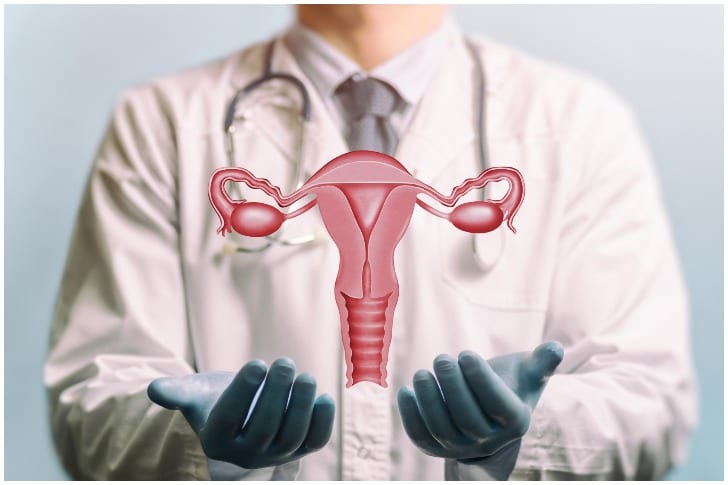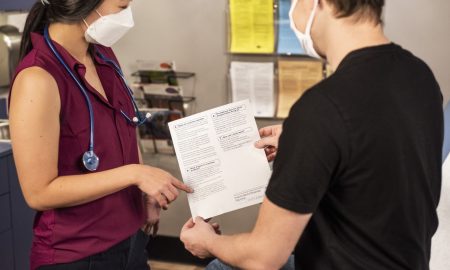
See How A Philadelphia Mother and Her Doctors Made History

Jennifer Gobrecht made history when she gave birth to a baby boy in November 2019. If you are wondering what was so special about it – she was the first American beneficiary to receive a uterus from a deceased donor. In 2017, Brazil’s Hospital das Clínicas became the first institution to achieve this rare feat.
How did things fall in place?

wavebreakmedia/Shutterstock: Gobrecht got to know about the Penn Hospital through Facebook
It all started with a Facebook group for women with MRKH, a unique disorder that results in a missing uterus. From one of the posts, Gobrecht found out that Penn Hospital was undertaking trials for a transplant and wasted no time in signing up for it.
Dr. Kathleen O’Neill, the principal investigator for this trial, mentioned that Gobrecht was a perfect fit owing to the preparation she had undergone. The 33-year-old from Philadelphia had created many embryos with IVF’s help before she went ahead with the actual procedure.
How was the transplant done?

SvetaZi/Shutterstock: A crucial surgery
A lot of preparation happened behind the scenes before the procedure since the trial was first of its kind. It was a 10-hour long surgery wherein the donor’s blood vessels were sown to the recipient’s body. The doctors connected both the vaginas via the endometrial canal till the inside portion of the uterus. Six months after the transplant took place, Dr. O’Neill planted an embryo in Gobrecht’s womb, which got her pregnant.
How did the delivery go?

LittleDogKorat/Shutterstock: The team’s efforts paid off and the procedure turned out successful
There were many backup staff members right next to the operating table, who also acted as an emotional support system. Dr. Paige Porrett, the surgeon responsible for the transplant, and her entire team were rooting for the delivery. Ultimately, the procedure was a great success.
Retaining the uterus meant that Gobrecht continuously had to take anti-rejection medication; hence, she decided not to try for a second child. Besides, the doctors believed that one healthy kid should be the ultimate goal of fertility treatments.
What lies ahead for uterus transplants?
Only after delivering 500 odd babies, the concept of in-vitro fertilization became popular. Similarly, the idea of uterus transplants from both living and deceased persons could take a while before gaining acceptance.
Gobrecht’s bold step has made waves and inspired 1500 women across the US to volunteer at Baylor University Medical Center and Penn Hospital for similar trials. Dr. O’Neill aims to create awareness of such treatments among all 500,000 women in the US who have issues of infertility. She further adds that the community needs more women like Gobrecht, who can aid medical fraternity and humanity.
More in Medicare
-
`
Best Home Energy-Saving Devices
In our world today, where caring for the environment goes hand in hand with making smart financial choices, discovering ways to...
November 18, 2023 -
`
Amazon’s Ambitious Investment in Anthropic
In a bold move, Amazon has announced a massive investment of up to $4 billion in Anthropic, an AI firm based...
November 9, 2023 -
`
What Are Data Silos in Healthcare & How AI Can Help Tear Them Down
In the ever-evolving landscape of healthcare, data is the heartbeat that keeps the system running. It is the lifeblood that flows...
November 1, 2023 -
`
Free Rail Travel in Austria? But How?
Have you ever dreamed of exploring Austria’s breathtaking landscapes and vibrant festivals without spending a dime on train tickets for an...
October 19, 2023 -
`
The Rise & Fall of FaZe Clan
In the ever-evolving gaming collectives, one name has stood out above all others: FaZe Clan. However, this beloved gaming conglomerate is...
October 15, 2023 -
`
Everything You Need to Know About Vaccine Technologies
You might remember that little pinch on your arm or a quick jab to the thigh as a child: A momentary...
October 3, 2023 -
`
Opinion: The Worst Movies of All Time
In filmmaking, where creativity knows no bounds and storytelling takes center stage, there are bound to be both shining gems and...
September 26, 2023 -
`
Exploring the World of Alternative Alcoholic Drinks
When it comes to alcoholic beverages, many of us tend to think of the usual suspects – beer, wine, and spirits....
September 22, 2023 -
`
Why Robots Will Boost Human Employment
The looming specter of job-stealing robots has haunted the workforce for years. But what if this fear is mainly unfounded? In...
September 16, 2023















You must be logged in to post a comment Login